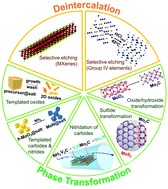Topochemical synthesis of 2D materials
Abstract
Since the demonstration of the unique properties of single-layer graphene and transition metal dichalcogenides (TMDs), research on two-dimensional (2D) materials has become one of the hottest topics, with the family of 2D materials quickly expanding. This expansion is mainly attributable to the development of new synthesis methods to create new materials. This review will summarize and critically analyze topochemical synthesis methods for synthesizing novel 2D materials. For example, the emerging family of 2D transition metal carbides, nitrides and carbonitrides (MXenes) are synthesized primarily by selective etching of “A” (metal) elements from MAX phases. Another 2D material, hydrogenated germanene is produced by selective etching of calcium digermanide (CaGe2). The topochemical transformation of one dichalcogenide into another and 2D oxides into 2D carbides or nitrides have attracted great attention because materials with many useful and diverse properties can be obtained by these methods. Topochemical synthesis methods provide alternative ways of synthesizing 2D materials not requiring van der Waals bonded solid precursors or vapor phase deposition, but they have not been comprehensively reviewed. In this review, we describe common principles of topochemical synthesis of 2D materials, explain synthesis mechanisms and offer an outlook for future research.

- This article is part of the themed collection: 2D nanomaterials: beyond graphene and transition metal dichalcogenides


 Please wait while we load your content...
Please wait while we load your content...